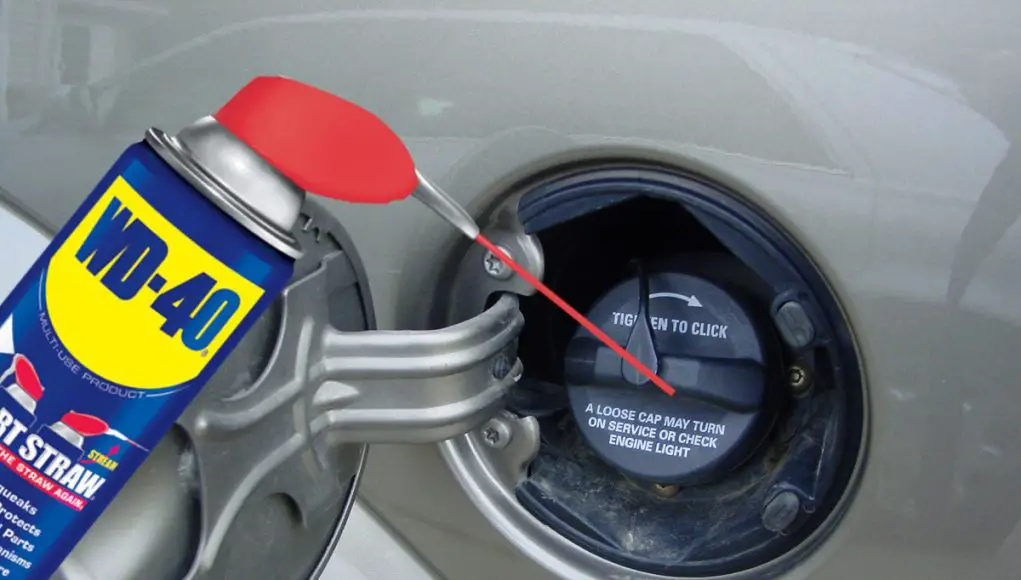Here’s what would likely happen if drove your car with a gigantic squirt of WD-40 sloshing in your gas tank.
WD-40 is one of the world’s most popular penetrants, often used for loosening stuck on parts and stopping speaks from metal-to-metal contact. The ubiquitous blue can also has dozens of other uses, ranging from sticker remover to pigeon deterrent (supposedly birds hate the smell.)
So, color me surprised to see an ad for one of those generic OBD-2 gas saver devices bating you to click by showing someone spraying WD-40 into your gas tank. There’s a good chance the ad might pop up on this blog post.
Please don’t put this lubricant spray in your gas pic.twitter.com/jM4IawmwIG
— TireMeetsRoad.com (@TireMeetsRoad_) February 24, 2022
“1 Simple trick to lower fuel consumption by 55%” the ad claims.
Here’s what would happen if you DID spray WD-40 into your gas tank.
Although WD-40’s exact formula is still a well-guarded secret, they do list what the spray is made of on their MSDS sheet: LVP Aliphatic Hydrocarbon, Aliphatic Hydrocarbon, and various petroleum base oils.
That’s still confusing, but, Wired did humanity a solid, sent a can of WD-40 to a lab, and returned with an exact chemical breakdown, simplifying what the MSDS says.
- Mineral Oil- mix of Alkanes and Cycloalkanes
- Decande- Alkane
- Noonane- Alkane
- Tridecane- Alkane
- Undecane- Alkane
- Tetradecane- Alkane
- Dimethyl Naphthalene- Polycyclic aromatic hydrocarbon
- Cyclohexane- Cycloalkanes
- Carbon Dioxide-
What this means is WD-40 is made up of a bunch of Alkanes (aka hydrocarbons,) Mineral oil, and, carbon dioxide.
WD-40 is both flammable and combustible, with flash point properties that more align with a heavy diesel than gasoline.
Knowing that the main ingredients of WD-40 are composed of combustible hydrocarbons, we can infer what will happen when combined with gasoline.
Gasoline, itself, is composed of energy dense hydrocarbons so WD-40 and gasoline will mix well together. A gasoline and WD-40 mixture probably won’t damage the tiny passages of your car’s fuel system. In fact, the mixture might even clean it up a bit.
When the gasoline and WD-40 mixture finally reaches one of your car’s cylinders, it will combust in the presence of simultaneously combusting gasoline, acting as a car fuel.
But, since WD-40 is not made of as many energy dense alkanes as gas, it dilutes the combustion energy of straight gasoline.
Like all hydrocarbons, combustion will produce carbon, hydrogen, and/or oxygen.
Youtube channel Project Farm put theory to the test and ran a lawn mower on equal parts WD-40 and gas, confirming our theory. WD-40 and gas works in a lawn mower engine, although, not very well, resulting in poor power and plumes of smoke.
We can safely conclude if you put WD-40 in your gas tank, your car will run slightly poorer, and you will notice increased exhaust fumes emitting from your tail pipe.
It will take more than a few squirts of WD-40, and more like half a can of the lubricant, for you to notice a difference, though.
WD-40 definitely will not improve gas mileage.




[…] are you aware that pouring some WD40 into your gas tank can act as fuel? Visit here to find […]
Per gallon, that would be some pretty expensive crappy fuel, lol.